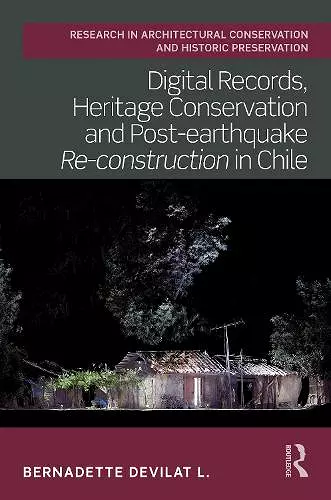Digital Records, Heritage Conservation and Post-earthquake Re-construction in Chile
Format:Hardback
Publisher:Taylor & Francis Ltd
Published:30th May '25
£145.00
Supplier delay - available to order, but may take longer than usual.

The conservation of built heritage implies constant intervention. One form of intervention is reconstruction, which, in the context of disasters, usually tries to bring buildings and places back to their previous state and is contested in heritage discourses. This book challenges reconstruction as a replica to physically preserve damaged built heritage by critically examining a context of constant change resulting from earthquakes – Chile – advocating for the digital record to be an analytical basis for design, following the principles embedded in historical domestic architecture.
Beyond monumental heritage, the focus is on the living heritage of the historical settlements of Tarapacá, Zúñiga, and Lolol, built with local resources and sustainable techniques. The book proposes re-construction as an alternative methodology, based on 3D-laser-scanning, photography, and questionnaires, to analyse the as-built condition of earthquake-affected buildings, consider risk mitigation, and recognise adaptation to earthquakes and subsequent reconstructions. This is relevant for seismic-prone areas and built heritage at risk in general.
This book is aimed at researchers, academics, and practitioners in architectural conservation and is also a valuable resource for authorities and stakeholders involved in post-earthquake scenarios.
It is easy, in countries where buildings can be expected to last for thousands of years if they are very well built and maintained with care, to believe that restoration back to the original is the be all and end all of preservation. But buildings of this nature are rare, and historical continuity over long periods to support continuous maintenance is close to non-existent. In addition, buildings are continually repurposed, and this will inevitably have an impact on their fabric.
Chile, with highly active earthquake zones and a rapidly developing culture and economy, is a petri dish in which concepts of conservation can be exposed to extreme challenges, and this book is a really welcome, erudite, and significant contribution to the subject. As society moves forward, it is plausible to believe that in many cases, a complete record of past buildings will become more significant than the retention of a few of the actual buildings.
Professor Stephen Gage, The bartlett School of Architecture, UCL
Relics, remnants, and records are something of the past that remains in the present, thresholds of knowledge that signify possibilities of the future. Bernadette Devilat’s book is bringing a novel and much needed discussion on the nature, form, and urgency of records, memory in the digital age as some form of contemporary Noah’s Arch to interpret the past to preserve some form of future of architecture and built environment in general. She is offering care and cautions, erudition and innovation with what she calls re-construction to a field of practice often left in a hurry to measure success, evidence, and novelty. Across disaster studies, architecture and digital design, Bernadette Devilat’s book is a needed reading for all interested in an architecture of hope.
Professor Camillo Boano, Polytechnic of Turin, Italy; and Development Planning Unit, London
ISBN: 9780367776237
Dimensions: unknown
Weight: 600g
268 pages